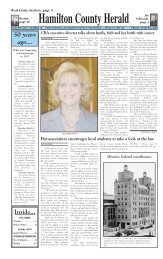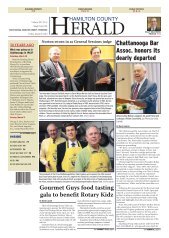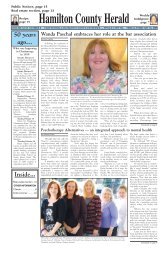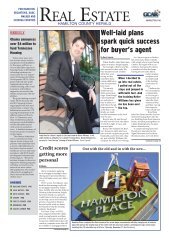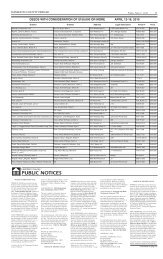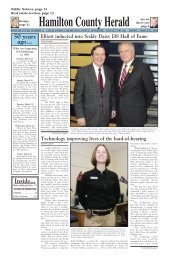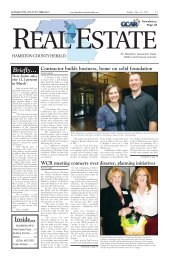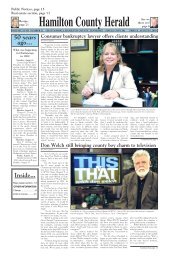Home staging gives sellers a leg up - Chattanooga Bar Association
Home staging gives sellers a leg up - Chattanooga Bar Association
Home staging gives sellers a leg up - Chattanooga Bar Association
You also want an ePaper? Increase the reach of your titles
YUMPU automatically turns print PDFs into web optimized ePapers that Google loves.
30 | Friday, March 16, 2012 Hamilton County Herald www.hamiltoncountyherald.com<br />
Optimistic outlook<br />
for apartment and<br />
condominium market<br />
RISMedia<br />
� e Multifamily Production Index (MPI), a leading indicator<br />
for the multifamily market recently released by the National<br />
<strong>Association</strong> of <strong>Home</strong> Builders (NAHB), showed steady improvement<br />
in the apartment and condominium housing market<br />
for a sixth consecutive quarter.<br />
� e MPI, which measures builder and developer sentiment<br />
about current conditions in the multifamily market on a scale<br />
of 0 to 100, increased from 47.3 in the third quarter to 48.9 in<br />
the fourth quarter – the highest reading since the fourth quarter<br />
of 2005.<br />
� e index provides a composite measure of three key elements<br />
of the multifamily housing market: construction of<br />
low-rent units, market-rate rental units and “for-sale” units, or<br />
condominiums. � e index and all of its components are scaled<br />
so that any number over 50 indicates that more respondents<br />
report conditions are improving than report conditions are<br />
getting worse. In the fourth quarter of 2011, the MPI component<br />
tracking builder and developer perceptions of marketrate<br />
rental properties recorded an all-time high of 64.3, while<br />
low-rent units increased as well to 55.5. For-sale units remained<br />
steady at 30.6.<br />
“� e apartment and condo sector continues to be a bright<br />
spot in the housing market, with the overall index at its highest<br />
level in six years,” says NAHB Chief Economist David Crowe.<br />
“� e rental components have been the driving force behind the<br />
increased index level. And although the for-sale component remains<br />
weaker, it is still double what it was just six quarters ago.”<br />
Although improvement has been shown in the multifamily<br />
segment, builders and developers say credit restrictions are<br />
aff ecting recovery. “Capital is limited in this current market, and<br />
developers are having a diffi cult time obtaining the credit needed<br />
to fi nance the development of new apartments,” says W. Dean<br />
Henry, president of Legacy Partners Residential in Foster City,<br />
Calif., and chairman of NAHB’s Multifamily Leadership Board.<br />
Looking forward to the next six months, builder and developer<br />
expectations improved in the fourth quarter for all<br />
three components: low-rent units, 57.0 (from 50.2 the previous<br />
quarter); market-rate rental units, 67.8 (from 67.2); and for-sale<br />
properties, 38.7 (from 37.3).<br />
� e Multifamily Vacancy Index (MVI), which measures<br />
the multifamily housing industry’s perception of vacancies,<br />
decreased from 35.1 in the third quarter to 34.7 in the fourth<br />
quarter. With the MVI, lower numbers indicate fewer vacancies.<br />
� e MVI has decreased two quarters in a row, and improved<br />
considerably since reaching a peak of 70.2 in the second<br />
quarter of 2009.<br />
Historically, the MPI and MVI have performed well as leading<br />
indicators of U.S. Census fi gures for multifamily starts and<br />
vacancy rates, providing information on likely movement in the<br />
Census fi gures one to three quarters in advance.<br />
FHA Continued from page 13<br />
Currently, 3.4 million households<br />
with loans endorsed on or<br />
before May 31, 2009, pay more<br />
than a fi ve percent annual interest<br />
rate on their FHA-insured mortgages.<br />
By refi nancing through this<br />
streamlined process, it’s estimated<br />
that the average qualifi ed FHAinsured<br />
borrower will save approximately<br />
$3,000 a year or $250<br />
per month. FHA’s new discounted<br />
prices assume no greater risk to<br />
its Mutual Mortgage Insurance<br />
(MMI) Fund and will allow many<br />
of these borrowers to refi nance<br />
into a lower cost FHA-insured<br />
mortgage without requiring additional<br />
underwriting. FHA-insured<br />
homeowners should contact their<br />
existing lender to determine their<br />
eligibility.<br />
Last month, the Obama Administration<br />
announced a broad<br />
package of actions and <strong>leg</strong>islative<br />
proposals to help responsible<br />
homeowners save thousands of<br />
dollars through refi nancing. � is<br />
includes the changes announced<br />
today that will benefi t current<br />
FHA borrowers – particularly<br />
those whose loan value may<br />
exceed the current value of their<br />
home. By lowering monthly<br />
mortgage costs for home-owners,<br />
FHA hopes to help more borrowers<br />
stay in their homes, thereby<br />
decreasing the potential for future<br />
default and reducing losses to<br />
the Mutual Mortgage Insurance<br />
(MMI) Fund.<br />
� e changes outlined in today’s<br />
mortgagee letter apply to all<br />
mortgages insured under FHA’s<br />
Single Family Mortgage Insurance<br />
Programs except:<br />
• Title I<br />
• <strong>Home</strong> Equity Conversion<br />
Mortgages (HECM)<br />
• Section 247 (Hawaiian<br />
<strong>Home</strong>lands)<br />
• Section 248 (Indian Reservations)<br />
• Section 223(e) (Declining<br />
Neighborhoods)<br />
For more information, visit<br />
www.hud.gov. ��<br />
Today, women-owned businesses make <strong>up</strong> an increasingly signifi cant percentage of the nation’s contractors. But the<br />
industry still has a long way to go. (Photo provided)<br />
Women-owned construction<br />
firms on the rise<br />
despite public perception<br />
By Lee Fehrenbacher<br />
The Daily Record Newswire<br />
When Tara Kramer, owner<br />
of Ri Ky Roofi ng in Portland,<br />
entered the construction industry<br />
25 years ago, it wasn’t like it<br />
is today.<br />
“It was male-dominated, most<br />
defi nitely,” she said. “In fact, the<br />
company that I joined had 40 offi<br />
ces nationwide and they didn’t<br />
have any saleswomen.”<br />
A lot has changed. Today,<br />
women-owned businesses make<br />
<strong>up</strong> an increasingly signifi cant<br />
percentage of the nation’s contractors.<br />
But the industry still has<br />
a long way to go.<br />
Kramer began working for<br />
CentiMark Corp., a large commercial<br />
fl ooring and roofi ng<br />
company, as a corporate receptionist.<br />
On a daily basis,<br />
she would speak with salesmen<br />
around the nation and ask them<br />
about their jobs. She said she saw<br />
the glass ceiling as a challenge<br />
and decided she was going to do<br />
that job despite what people told<br />
her was possible.<br />
“You need to know more than<br />
your male counterparts,” Kramer<br />
said of the early advice she<br />
received from mentors. “It’s not<br />
(fair), but that’s just the way it’s<br />
going to be.”<br />
So she studied day and night<br />
to learn about the company’s<br />
products. When she went into<br />
meetings, she knew what ethylene<br />
propylene diene monomer<br />
was and could explain the chemical<br />
components of diff erent roofing<br />
membranes.<br />
Kramer soon became one of<br />
three women to join the company’s<br />
sales ranks and was the fi rst<br />
woman to open her own offi ce<br />
in Portland. Even then, she said,<br />
people underestimated her.<br />
“(I was) almost already set <strong>up</strong><br />
for, ‘Hey, if it doesn’t work out …<br />
hey, you’re a woman,’ ” she said.<br />
Today, women-owned small<br />
businesses are one of the fastest<br />
growing segments of the U.S.<br />
economy. In 1972, fewer than 5<br />
percent of the nation’s companies<br />
were owned by women. In 2007,<br />
according to the most recent survey<br />
from the U.S. Census Bureau,<br />
nearly 29 percent of the approximately<br />
27 million U.S. fi rms were<br />
owned by women.<br />
But the number of womenowned<br />
construction fi rms<br />
remains comparatively small. In<br />
2007, only 5.94 percent of the nation’s<br />
employer companies were<br />
women-owned construction<br />
fi rms; 17 percent were maleowned<br />
construction fi rms. And<br />
that number for women-owned<br />
fi rms is only slightly higher than<br />
it was fi ve years earlier.<br />
Penny Pompei, executive<br />
director of Women Construction<br />
Owners and Executives, a<br />
national organization, said work<br />
still needs to be done to level the<br />
playing fi eld.<br />
“I think the biggest problem is<br />
public perception,” she said.<br />
Pompei said that people often<br />
think of women-owned construction<br />
companies as small<br />
painting or landscaping contractors.<br />
“If you tell them that womenowned<br />
construction companies<br />
build bridges and airports and<br />
high-rise buildings, and we have<br />
manufacturing companies that<br />
make the curtain wall systems<br />
that are used in high-rises …<br />
that’s where the surprise is,” she<br />
said. “It’s the perception that<br />
women don’t own major companies,<br />
when the reality is we have<br />
our fi ngers in everything.”<br />
� e construction industry<br />
was a natural fi t for Pompei. Her<br />
father was in the business and so<br />
she grew <strong>up</strong> around conversations<br />
about creating buildings.<br />
She started an architectural fi rm<br />
in the 1980s and later began<br />
a company called DKM Construction<br />
that specialized in<br />
constructing fi nancial buildings,<br />
hotels and casinos.<br />
For Pompei, the love of the job<br />
came from a feeling of ownership<br />
that many in the industry share.<br />
“� ere’s nothing like having a<br />
building that you know has your<br />
name on it,” she said. “It’s like<br />
carving your initials in a tree that<br />
you know is going to be there for<br />
100 years.”<br />
But even in 2012, Pompei said<br />
women still face discrimination<br />
when they walk into a bank and<br />
ask for a construction loan. She<br />
said bankers still wonder, “Who<br />
is behind you? Can we talk to<br />
your husband? Can we talk to<br />
your father?”<br />
Kramer, however, said she is<br />
accepted a lot more these days.<br />
“When (I) walk into a boardroom<br />
now, or a general contractor’s<br />
meeting, (I) don’t get that<br />
‘shock and awe’ look that I used<br />
to get,” she said.<br />
But she added that she understands<br />
it is a male-dominated<br />
industry. � e “good ol’ boys club”<br />
still exists and it probably always<br />
will, she said.<br />
But she doesn’t let that discourage<br />
her.<br />
Her roofi ng company, which<br />
opened for business in 2007 at<br />
the onset of the recession, now<br />
has offi ces in Oregon, Washington<br />
and Pennsylvania; expansion<br />
is planned for Hawaii and<br />
Arizona. She also has a separate<br />
solar panel installation company<br />
called Cool Planet Solar. All of<br />
that success has required hard<br />
work – 80 hours a week – as well<br />
as a love for building buildings<br />
and breaking down barriers.<br />
“It is a challenge,” she said. “It’s<br />
that ‘Don’t tell me I can’t do it, because<br />
then I’m going to do it.’ ” ��



